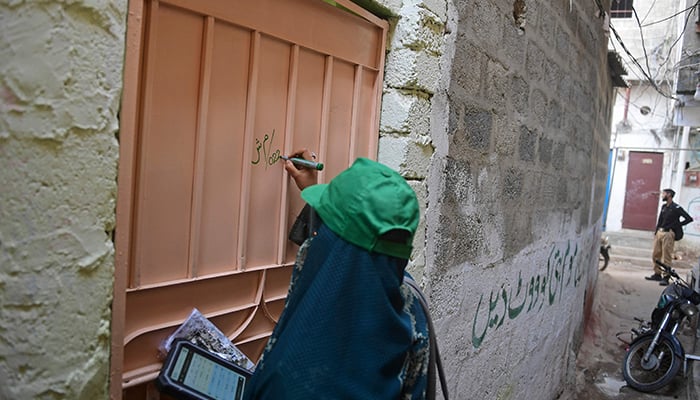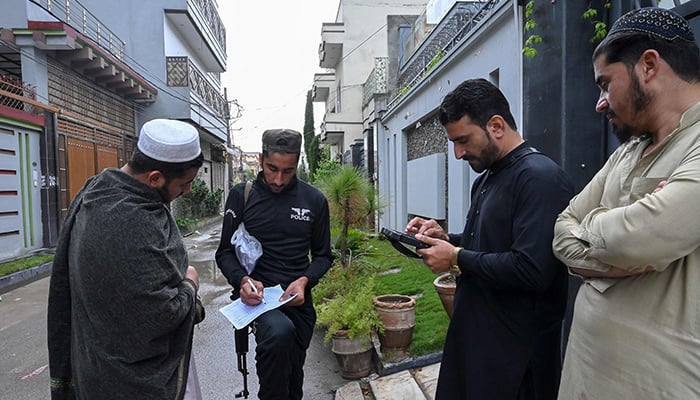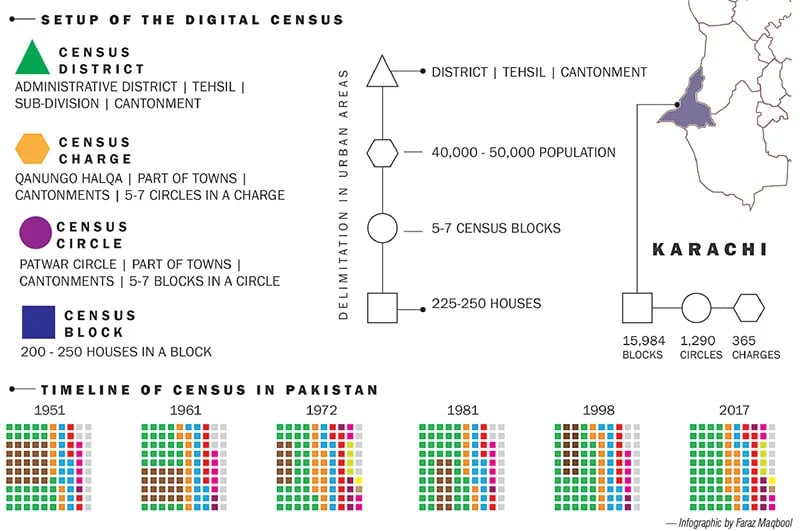Accurate census to shut the door on gerrymandering
Karachi has a total of 365 census charges, 1,290 census circles and 15,984 census blocks; each block comprises 200 to 250 houses, each circle has five to seven blocks, and each charge has five to seven circles.
Allegations of gerrymandering have marred the electoral history of Karachi for decades. Even the recent local government elections in the city became controversial due to the boycott of the Muttahida Qaumi Movement-Pakistan over what it said were fake union committees that were created as a result of gerrymandering.
This time around, there is hope. Fresh delimitations will have to take place before the upcoming general elections as the country is undergoing its seventh population and house count, which is also its first-ever digital census.
The Constitution’s Article 51(5) makes it mandatory to allocate seats in the National and provincial assemblies on the basis of the population in accordance with the latest census.
This means that there will be fresh delimitations of electoral constituencies after the census and if this is done in the spirit of Election Rules 2017, gerrymandering could be avoided.
Article 160(2) of the Constitution deals with the distribution of resources between the federation and provinces through the National Finance Commission whose basic parameter is the population size of the respective province, which would also be determined through the fresh census.
Let’s take a look at how the census is taking place, particularly in the Karachi division.
Digital census
In a bid to ensure accuracy in the census results, the Pakistan Bureau of Statistics (PBS), which is mandated to hold the census under the General Statistics (Reorganization) Act 2011, has decided to carry out the population and house count digitally for the first time.
This census will prove crucial in redrawing the country’s political map during the time the nation grapples with an unprecedented economic crisis.
The PBS chief statistician, Dr Naeem uz Zafar, told The News that hardly 10 per cent of the country’s area did not have internet connectivity, due to which the census could not be held there through digital means.
He explained that even though some peripheries of urban areas had low internet connectivity, the tablets provided to the enumerators worked offline and whenever the enumerators got an internet connection, their enumerated data was uploaded.
The PBS, he said, had 495 census support centres at the tehsil level with proper internet connections and as the enumerators reached those centres, their data was uploaded. Even 750 NADRA centres, he said, were synced with the PBS database.
Census method
The first census was held in Pakistan in 1951 followed by another in 1961. The third census took place in 1972 and the fourth in 1981.
The cycle of around a 10-year delay between the two censuses was disrupted in the decade of 1990s as the fifth census took place in 1998. The sixth census was further delayed as it was held after around two decades in May 2017.
There have been two methods of census enumeration: de-jure and de facto. In the de-facto approach, persons are counted where they are found on the day of the census. This census is a one-day activity.
However, in the de-jure method, which is being used in the current census, persons are counted at their usual place of residence, and it lasts about a month.
In the 1998 census, both approaches were applied simultaneously during the enumeration, but the data was tabulated and published on a de-jure basis to make the comparison of data over time possible.
Self-enumeration
On the recommendations of the Census Advisory Committee (CAC), the PBS gave a provision of a secured self-enumeration portal to everyone in Pakistan in a bid to make the “process more transparent and widely accepted by the masses in order to build confidence building measures on this national level assignment.”
The process of self-enumeration kicked off on February 20 and was supposed to last until March 3. However, at the request of the Sindh government, the date was extended until March 10, said the PBS chief statistician.
Around 15 million people had logged in for the self-enumeration, Dr Zafar said, adding that roughly over 0.3 million of them had successfully self-enumerated.
“Our expectation of self-enumeration was one per cent,” he said, stating that 0.3 million was not a good number.
The PBS started door-to-door enumeration of buildings throughout the country from March 1 till March 10. There was a break on March 11 and on March 12, the population count kicked off, the chief statistician explained.
House count
There are a total of two forms in the digital census: the house listing form 1, which has 11 questions that are about details of the building and form 2 which has 19 questions regarding age, gender, religion, nationality, literacy/education attainment, economic activity, functional limitation and migration.
According to the PBS’s Field Operation Plan (FOP) manual, the enumeration of buildings, houses and households with the name of the head of the household or any responsible person of that household with his mobile or landline phone number would be recorded on the House Listing Form (Form-I) with reference to the existing position on the day of house listing operation.
The manual reads that for the first time, economic institutions/establishments would also be entered in form 1 with their head/manager of the institution/establishment with the mobile phone/landline number. “All the buildings will be geo-tagged during House Listing Operation.”
During the house count the enumerators are advised to count buildings in a clockwise sequence and put three-digit numbers on each building. If there is a high-rise residential building with 40 apartments in any block, its structure would be given a three-digit number like 007, if the structure is seventh in counting. The first apartment in that building would be numbered 007/001 and the last one would be numbered 007/040.
If a commercial structure has four or more floors, it will be considered a high-rise commercial building and would be given a three-digit number in order of the structure count.
Shops or offices in that building would be mentioned separately in the form no 1, but would not be given separate numbers.
According to the manual, all the under-construction buildings that have walls, roofs and an entry gate would be counted and given a number. Even if a cave or a ship is inhabited, it would be counted as a structure in the census.
Shanties, camps and jhuggis would also be enumerated during the census. Any structure which is being demolished or orders have been given for its demolition would not be counted.
Who to be counted?
Everyone living in the country on the first day of the census, notwithstanding their possible death or emigration after that date, would be counted in the census.
Even foreign nationals would be counted with the exception of diplomats and their families.
Children born after March 1 or immigrants who entered the country after the dawn of the date would not be counted.
Overseas Pakistanis will not be covered in the census, however, there is a question in the census form regarding the number of family members living abroad.
“In addition to this, such members of a household who are temporarily away but not for more than six months on a visit or for business etc. will also be enumerated at their usual place of residence,” the manual reads, adding that any previous household members who are living somewhere else would be counted at the place where they are presently living.
“The important point to remember is to count everyone but only once,” reads the manual.
In column eight of form 2, all the Pakistanis, Afghans, Bengalis and Chinese would be counted under a separate nationality code. People of all other nationalities would fall in the ‘others’ category.
Census districts
In a bid to conduct the census swiftly, the PBS has demarcated the entire country into “small compact areas called census blocks”.
Each block is supposed to have 200 to 250 houses on average. This time, the PBS has divided the country into a total of 185,509 blocks with “well-defined boundaries and maps”.
Before the commencement of the census exercise, the PBS obtained details of different administrative units from all the provincial boards of revenues (BoR) and local government departments. The administrative units include divisions, districts, sub-divisions, tehsils, etc.
“Changes occur in the boundaries of administrative units during the intercensal period due to creation of new units or reconstitution of older ones,” reads the manual.
Boundaries of all the administrative units were frozen from April 1, 2022, onwards so that the final list of the census boundaries prepared by the PBS could not be changed until the census operation was over.
It is pertinent to mention here that there is a difference between the census district and the administrative district.
Economist Dr Asim Bashir, who has expertise in local government laws and census, explained that divisions are revenue or administrative boundaries under the commissioners and they comprise several administrative districts under the deputy commissioners.
The sub-divisions are the jurisdiction of the assistant commissioners.
Dr Zafar explained that the census districts comprise sub-divisions, tehsils and cantonment areas mostly and not necessarily always based on the administrative districts.
According to the PBS manual, in Punjab, Sindh and Khyber Pakhtunkhwa tehsils, talukas or sub-divisions have been designated as the census districts, and all the cantonment areas have also been declared as separate census districts.
In Balochistan, Islamabad, Gilgit-Baltistan and Azad Jammu & Kashmir, the administrative districts have been declared as the census districts.
Karachi is a division that has seven administrative districts. However, the PBS has demarcated 37 different census districts comprising sub-divisions, being headed by respective assistant commissioners.
These 37 census districts also include the six cantonment boards of the city.
The census districts are further divided into census charges, census circles and census blocks.
As per the census manual, the census blocks comprise 200 to 250 houses. The census circle is kind of a mohalla that comprises five to seven blocks. Meanwhile, five to seven circles constitute a census charge.
Karachi has a total of 15,984 blocks, 1,290 circles and 365 charges, according to PBS Karachi Coordinator Faraz Muslim. Each enumerator has been assigned one block, while 1,290 supervisors appointed by the PBS are responsible for 14 to 16 blocks in the city.
The census manual clearly mentions the boundaries of a block, which can be the main road, street, river, nullah or any other prominent location. During the house count, if any enumerator finds more than 250 buildings in his or her designated block, the supervisor can provide an additional enumerator for assistance.
Delimitation laws
If the city's population is enumerated properly and the FOP manual is strictly followed, the city can have general elections devoid of gerrymandering. However, the Election Rules 2017 would also have to be abided by in letter and spirit.
Dr Bashir explained that the National Assembly and provincial assemblies’ constituencies were delimited from circles and charges, while union councils or union committees were delimited on the basis of blocks.
The Election Rules 2017 say that the delimitations of constituencies of general seats in any assembly have to be done on the basis of the population in accordance with the last preceding census.
The delimitation committee has to obtain the population data along with relevant maps showing census charges, circles and blocks from the PBS.
The rules stipulate that the constituency for an assembly shall not ordinarily extend to more than one district except in exceptional circumstances and in the case of urban areas, the census circle shall not be broken under any circumstances. Violation of this rule, according to Dr Bashir, opens the doors to gerrymandering.
In case of local government delimitations, a ward or a union council or union committee should be as far as possible equal in population and variation should not be more than 10 per cent. The rules also prohibit breaking the census block during the delimitation process.
-
 Harvey Weinstein's New Request Denied Amid Sexual Assault Conviction
Harvey Weinstein's New Request Denied Amid Sexual Assault Conviction -
 Meghan Markle Talks About Her Personal Philosophy Towards Raising Lilibet, Archie
Meghan Markle Talks About Her Personal Philosophy Towards Raising Lilibet, Archie -
 Sophie Turner Names Jewellery She Believes Was Her Lucky Charm For X-Men Audition
Sophie Turner Names Jewellery She Believes Was Her Lucky Charm For X-Men Audition -
 David Tennant And Wife Georgia Moffett Formally Change Their Last Names
David Tennant And Wife Georgia Moffett Formally Change Their Last Names -
 Prince George's Diana Tribute Video Hits New Record
Prince George's Diana Tribute Video Hits New Record -
 Buckingham Palace Statement Signals King Charles' Return To London
Buckingham Palace Statement Signals King Charles' Return To London -
 Paul Mescal Gets Candid About His 'animalistic' Shakespeare In 'Hamnet'
Paul Mescal Gets Candid About His 'animalistic' Shakespeare In 'Hamnet' -
 Kate Hudson Responds After Real-life Son Brands 'Song Sung Blue' 'all Lies'
Kate Hudson Responds After Real-life Son Brands 'Song Sung Blue' 'all Lies' -
 King Charles' Aide Resigns
King Charles' Aide Resigns -
 Prince Harry, Meghan Back Key 'movement' In Surprise Oprah Appearance: 'Much-needed'
Prince Harry, Meghan Back Key 'movement' In Surprise Oprah Appearance: 'Much-needed' -
 Kristin Cavallari Reveals Details Of 'nasty Fight' At Home
Kristin Cavallari Reveals Details Of 'nasty Fight' At Home -
 Blake Lively, Justin Baldoni Feeling Emotional Strain After Year Long Court Battle: Report
Blake Lively, Justin Baldoni Feeling Emotional Strain After Year Long Court Battle: Report -
 Bowen Yang Opens Up About Leaving 'SNL'
Bowen Yang Opens Up About Leaving 'SNL' -
 Beatrice, Eugenie’s Agenda Behind Steering Clear Of Dad Andrew Exposed: ‘They’re His Passport’
Beatrice, Eugenie’s Agenda Behind Steering Clear Of Dad Andrew Exposed: ‘They’re His Passport’ -
 Kim Kardashian Loves This Kanye West Creation: 'Made For Me'
Kim Kardashian Loves This Kanye West Creation: 'Made For Me' -
 Jennifer Aniston's Workout Secret Disclosed By Longtime Personal Trainer
Jennifer Aniston's Workout Secret Disclosed By Longtime Personal Trainer








